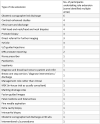A mixed method study into obstetric sonographer-led-discharge and other forms of sonographer role extension
- PMID: 35936963
- PMCID: PMC9354179
- DOI: 10.1177/1742271X211038296
A mixed method study into obstetric sonographer-led-discharge and other forms of sonographer role extension
Abstract
Introduction: Sonographer-led-discharge was proposed in a maternity unit to provide a holistic service, cut waiting times, ease staffing pressures and increase job satisfaction. This study explored sonographers' experiences and perspectives of this new extended role and other areas of non-obstetric role extension. Understanding these will inform future practice and the success of the proposed obstetric sonographer-led-discharge and career structure.
Methods: A mixed methodology, cross-sectional study was performed, with a purposive, non-probability sample using an online data collection tool. The data were analysed using descriptive statistics and thematic analysis.
Results: In total, 93 sonographers participated in the study. Of these, 25% of sonographers currently practising obstetric ultrasound said they would not undertake the proposed obstetric sonographer-led-discharge role extension although 90% of the participants said role extension provides job satisfaction. Several themes emerged from the data, including job satisfaction, benefits to the hospital, improved patient pathway, time, personal factors, litigation and intra- and interprofessional resistance. A total of 54% of staff currently performing a role extension have experienced either inter- or intraprofessional conflict and only 48.5% said their workload was manageable.
Conclusions: The data collected suggested that, with training and support, the proposed obstetric sonographer-led-discharge role is an appropriate role extension for sonographers. These findings support the premise of the proposed sonographic career structure, although the inter- and intraprofessional resistance identified in the study could form a significant barrier if it is not appropriately considered and managed.
Keywords: Advanced practice; career progression framework; role development; sonographic career structure.
© The Author(s) 2021.
Conflict of interest statement
Declaration of conflicting interests: The author(s) declared no potential conflicts of interest with respect to the research, authorship, and/or publication of this article.
Figures
Similar articles
-
Embedding new technology into clinical ultrasound practice: Is role extension for sonographers the key to improving patient pathways?Ultrasound. 2023 May;31(2):84-90. doi: 10.1177/1742271X221139210. Epub 2022 Dec 27. Ultrasound. 2023. PMID: 37144232 Free PMC article. Review.
-
"It has been the most difficult time in my career": A qualitative exploration of UK obstetric sonographers' experiences during the COVID-19 pandemic.Radiography (Lond). 2023 May;29(3):582-589. doi: 10.1016/j.radi.2023.03.007. Epub 2023 Mar 21. Radiography (Lond). 2023. PMID: 37004376 Free PMC article.
-
Sonographers' communication in obstetrics: Challenges to their professional role and practice in Australia.Australas J Ultrasound Med. 2019 Nov 2;23(2):129-139. doi: 10.1002/ajum.12184. eCollection 2020 May. Australas J Ultrasound Med. 2019. PMID: 34760592 Free PMC article.
-
Exploring sonographer emotional well-being: NHS sonographers' experience of the restorative function of professional supervision.Ultrasound. 2023 May;31(2):147-154. doi: 10.1177/1742271X221131482. Epub 2022 Nov 16. Ultrasound. 2023. PMID: 37144227 Free PMC article.
-
Dangers in the dark: Calling for a safer practice of transvaginal ultrasonography.Australas J Ultrasound Med. 2020 Dec 5;24(1):5-12. doi: 10.1002/ajum.12234. eCollection 2021 Feb. Australas J Ultrasound Med. 2020. PMID: 34765410 Free PMC article. Review.
Cited by
-
Embedding new technology into clinical ultrasound practice: Is role extension for sonographers the key to improving patient pathways?Ultrasound. 2023 May;31(2):84-90. doi: 10.1177/1742271X221139210. Epub 2022 Dec 27. Ultrasound. 2023. PMID: 37144232 Free PMC article. Review.
References
-
- Blencowe H, Cousens S, and Jassir FB. National regional and worldwide estimates of stillbirth rates in 2015, with trends from 2000: a systematic analysis. Lancet Global Health 2016; 4: e98–e108. - PubMed
-
- NHS England. Saving babies’ lives: a care bundle for reducing stillbirth, www.england.nhs.uk/wp-content/uploads/2016/03/saving-babies-lives-car-bu... (2016, accessed 24 February 2021).
-
- NHS England. Saving babies’ lives care bundle version 2, www.england.nhs.uk/wp-content/uploads/2019/03/saving-babies-lives-care-b... (2019, accessed 24 February 2021).
-
- Office for National Statistics. Births in England and Wales, 2017. London: Office for National Statistics, 2018.
LinkOut - more resources
Full Text Sources







